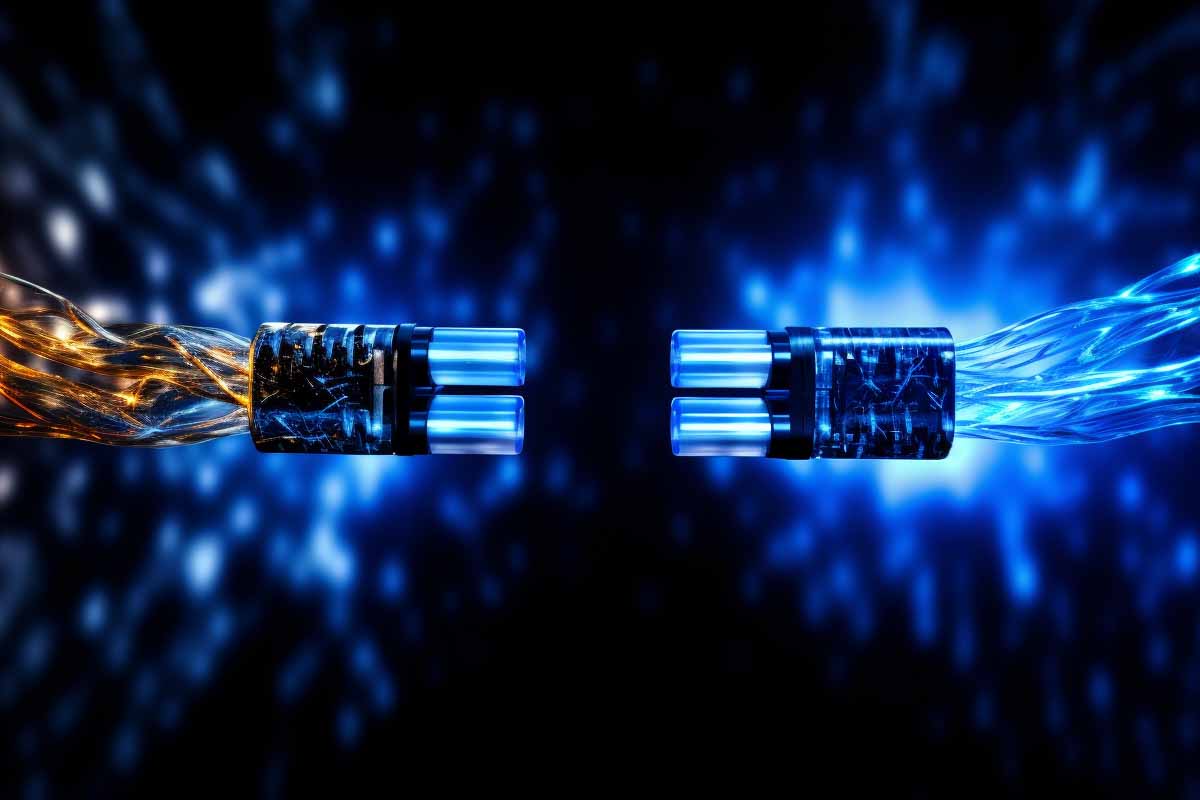The Importance of Choosing Between 802.3af and 802.3at in Power over Ethernet Networks
Making the correct choice between 802.3af and 802.3at isn’t merely a technical detail—it’s a fundamental decision that can significantly affect the overall performance and reliability of your Power over Ethernet (PoE) network. These two IEEE standards serve as the backbone for PoE technology, allowing both data and power transmission to occur simultaneously over a single Ethernet cable. But their distinct features and capabilities mean that they’re suited for different kinds of PoE applications, from IP cameras and wireless access points to other sophisticated end devices.
In addition to affecting your current network needs, the choice between these two standards will also influence future scalability, your PoE budget, and even the kind of network infrastructure you can build or expand upon. The more accurately you assess your current and future requirements, the more efficiently you can use either the 802.3af or the 802.3at standard to meet them. In this comprehensive guide, we’ll dissect the crucial factors you must consider, including the pros and cons of each standard, to help you make the most informed decision for your networking needs.

Lock In Our Lowest Price Ever For Only $14.99 Monthly Access
Your career in information technology last for years. Technology changes rapidly. An ITU Online IT Training subscription offers you flexible and affordable IT training. With our IT training at your fingertips, your career opportunities are never ending as you grow your skills.
Plus, start today and get 10 free days with no obligation.
Table of Contents
- Understanding the Basics of PoE
- 802.3af vs 802.3at: Key Differences
- Impact on Network Design
- Compatibility Issues: 802.3af and 802.3at
- Applications: Where to Use Which
- Maximizing Your PoE Budget
- Overcoming PoE Limitations
- Conclusion: Making an Informed Decision
Unpacking Power over Ethernet (PoE)
What is Power over Ethernet?
Power over Ethernet (PoE) is not just a trend but an enduring solution for modern network design. It simplifies the complexities often involved in network infrastructure by carrying electrical power alongside data over Ethernet cables. Think of it as a two-for-one deal: you get both data and power transmission through a single Ethernet port, thereby reducing cabling requirements, lowering installation costs, and making maintenance a breeze.
However, it’s essential to understand that PoE is not a one-size-fits-all solution. Different needs and applications call for different standards. Here, we primarily focus on the 802.3af and 802.3at standards, each with unique capabilities and limitations.
The Role of IEEE in Standardizing PoE
The Institute of Electrical and Electronics Engineers (IEEE) plays a pivotal role in standardizing PoE technology. For those who might not be familiar, IEEE is an organization responsible for establishing a broad spectrum of standards across engineering disciplines. In the context of PoE, the IEEE has delineated two key standards: 802.3af and 802.3at.
These standards serve as the rulebook for PoE technology. They outline everything from the allowable power sourcing equipment (PSE) like PoE switches and PoE injectors to PoE wattage limitations and even network design protocols. They also specify the kind of Ethernet cables that can be used, such as Cat 5e or higher, which play a role in network reliability and the quality of both data and power transmission.
The IEEE standards go beyond just technical specifications, serving as a guideline for best practices in PoE applications. Whether you’re setting up a new local area network (LAN) infrastructure or looking to upgrade an existing one, being aware of these standards can help you make choices that are both cost-effective and future-proof.
By meticulously defining the parameters for data and power transmission, Ethernet networking protocols, and PoE wattage, the IEEE standards help eliminate the guesswork from network design. This, in turn, makes it easier for network architects and IT professionals to plan, deploy, and manage their network infrastructure efficiently.
So, understanding these IEEE standards isn’t just a matter of technical compliance—it’s about ensuring that your network is robust, scalable, and able to meet the varied power requirements of different PoE devices, from basic to high-performance.
In the following sections, we will delve deeper into the specifics of the 802.3af and 802.3at standards, helping you make an informed decision that aligns with your network architecture, PoE budget, and the range of applications you intend to support.
802.3af vs 802.3at: Understanding the Key Differences
Distinguishing between 802.3af and 802.3at is vital for anyone responsible for setting up or maintaining a Power over Ethernet (PoE) network. The two standards have distinct characteristics, making them suitable for various applications and network architectures. This section will shed light on the critical differences to help you determine which standard best suits your needs.
| Feature | 802.3af (PoE) | 802.3at (PoE+) |
|---|---|---|
| Maximum Power (Wattage) | 15.4 W | 25.5 W |
| Voltage Range | Lower | 48-56 V |
| Ideal for Device Types | Basic IP cameras, VoIP phones | Advanced IP cameras, Industrial controls |
PoE Classifications: Power Ratings and Device Types
The most straightforward way to differentiate between 802.3af and 802.3at is through their power classifications. Also known as the “regular PoE,” the 802.3af standard typically delivers power up to 15.4 watts per port. On the flip side, the 802.3at standard, better known as PoE+, provides power up to 25.5 watts per port.
This divergence in PoE wattage impacts the range of devices that each standard can support. For instance, the 802.3af standard is generally suitable for low-power devices like basic IP cameras, network switches, and other end devices. In contrast, the 802.3at standard is designed to power higher-end devices such as advanced IP cameras with heater elements or PTZ capabilities, Wi-Fi access points with multiple antennas, and even thin clients.
PoE Voltage and Power Delivery: Matching Needs with Capabilities
Another distinguishing factor between 802.3af and 802.3at is their voltage and power delivery capabilities. While 802.3af operates at a relatively lower voltage range, delivering around 44-48 volts, the 802.3at standard offers an expanded range, typically between 48-56 volts. This becomes particularly critical when you’re dealing with PoE applications that require more energy, like advanced IP cameras with heaters or PTZ functionalities.
Understanding the voltage requirements of your devices is essential for ensuring PoE compatibility and overall network reliability. Therefore, if your applications demand higher power levels, opting for the 802.3at standard might be the more prudent choice.
Network Switches: The Foundation of Your LAN Infrastructure
| Criteria | 802.3af (PoE) | 802.3at (PoE+) |
|---|---|---|
| Ethernet Cable Requirement | Cat 5e or higher | Cat 5e or higher |
| Data Speeds | Standard | Gigabit Ethernet |
| Network Reliability | Moderate | High |
Your choice between 802.3af and 802.3at doesn’t only affect your PoE budget but also dictates the type of network switches you’ll need. Generally, 802.3af-compatible switches are more cost-effective but offer limited power capabilities. They are often adequate for smaller networks or setups with lower power demands. However, if your LAN infrastructure involves a wide array of power-hungry devices, investing in 802.3at-compatible switches might be inevitable.
It’s worth noting that 802.3at network switches are typically more robust, offer greater power sourcing capabilities, and come with more advanced features. While they may put a dent in your initial PoE budget, they offer greater flexibility and scalability for future network design and expansion.
The Ripple Effect of Choosing 802.3af vs 802.3at on Network Design
Your choice between 802.3af and 802.3at doesn’t only affect individual devices; it has broader implications on your entire network design, influencing everything from cable choices and data speeds to equipment compatibility. In this section, we’ll dissect how these seemingly minute details can collectively shape your network’s overall efficiency, reliability, and functionality.
Ethernet Cable Choices: The Lifeline of Your Network
Ethernet cables are the unsung heroes of any network, providing the critical link between your devices and power sourcing equipment like PoE switches or PoE injectors. For both 802.3af and 802.3at, it’s generally recommended to use Cat 5e cables or higher. The quality of the Ethernet cable you choose can dramatically affect both data and power transmission. A sub-par cable can introduce latency, lower the quality of service, and even pose a risk to the connected devices due to unreliable power delivery. Therefore, the type of Ethernet cable you choose can have a lasting impact on network reliability and performance.
Gigabit Ethernet and Data Speeds: A Match Made for Modern Networks
When we talk about modern network design, data speed is often a primary concern, especially for businesses that rely on data-intensive applications like video conferencing, high-definition IP cameras, or complex data analytics. If your network architecture demands high-speed data transmission, 802.3at, paired with Gigabit Ethernet, can offer a more robust solution. Unlike 802.3af, which may struggle to maintain high data speeds while also powering devices, 802.3at’s higher PoE wattage and compatibility with Gigabit Ethernet make it more suitable for demanding network environments.

Lock In Our Lowest Price Ever For Only $14.99 Monthly Access
Your career in information technology last for years. Technology changes rapidly. An ITU Online IT Training subscription offers you flexible and affordable IT training. With our IT training at your fingertips, your career opportunities are never ending as you grow your skills.
Plus, start today and get 10 free days with no obligation.
Navigating Compatibility Issues: 802.3af and 802.3at
Power Sourcing Equipment and End Devices
Before deploying your Power over Ethernet network, you’ll need to consider compatibility between your power sourcing equipment (PSE)—like PoE switches or PoE injectors—and the end devices you plan to connect, such as IP cameras, VoIP phones, and wireless access points. Generally speaking, 802.3at is backward compatible with 802.3af. This means you can safely connect 802.3af devices to an 802.3at-enabled switch. However, the reverse is not true; connecting 802.3at devices to an 802.3af switch can result in insufficient power delivery and limited functionality.
PoE vs PoE+: Understanding the Limitations
While it’s true that 802.3at (PoE+) devices can generally work on 802.3af (PoE) switches by automatically scaling down their power requirements, doing so might restrict the range of functions they can perform. For example, a high-end IP camera might work but without some of its advanced features like heater or PTZ functionalities. Thus, it’s crucial to factor in PoE and PoE+ compatibility when planning upgrades or integrating new equipment into your existing network infrastructure.
Applications: Choosing Between 802.3af and 802.3at for Diverse Network Needs
The implementation of 802.3af vs 802.3at standards extends far beyond powering generic devices; it can profoundly impact the efficiency and functionality of specific applications. Let’s dive deeper into some common PoE applications and how the choice of standard can affect their performance.
IP Cameras and Surveillance: Powering Your Eyes in the Sky
Security is a pivotal aspect of any organization, and choosing the right standard can make all the difference in your surveillance network. While 802.3af may suffice for basic surveillance needs, advanced IP cameras often require the extra wattage provided by 802.3at. Cameras with high-resolution sensors, night vision, and motion detection often consume more power, making 802.3at an ideal choice for a versatile and reliable surveillance system.
Networking Protocols and Applications: One Size Doesn’t Fit All
Your selection between 802.3af and 802.3at also intersects with the networking protocols you aim to deploy. For instance, while 802.3af can comfortably power VoIP phones and simpler wireless access points, other applications like industrial controls or advanced IoT devices often demand higher power levels. It’s essential to consider the needs of your specific applications, be it video conferencing, high-throughput data analytics, or specialized network architecture, to guide your choice effectively.
Financial Considerations: Maximizing Your PoE Budget for Long-term Efficiency
Budget is a critical component of any network design, encompassing everything from Ethernet ports to PoE switches and even network reliability measures. Here’s how the two PoE standards weigh in.
| Aspect | 802.3af (PoE) | 802.3at (PoE+) |
|---|---|---|
| Cost | Lower | Higher |
| PoE Budget Efficiency | Moderate | High |
| Backward Compatibility | N/A | Yes (with 802.3af) |
Cost-effectiveness vs High-performance: A Delicate Balance
For startups or smaller networks looking for immediate cost-savings, 802.3af can offer a more budget-friendly approach. Its lower PoE wattage requirements often mean that both the PSE and Ethernet cables are cheaper. On the other hand, if you’re dealing with high-performance or mission-critical devices, 802.3at, though more expensive upfront, can provide a better return on investment over time by supporting more advanced applications and offering better scalability.
Overcoming PoE Limitations: When Theory Meets Practice
Despite its numerous advantages, Power over Ethernet technology has its limitations, including distance restrictions and power loss over cables. Both 802.3af and 802.3at are not immune to these challenges.
Distance and Power Loss: Bridging the Gap
Standard Ethernet limitations stipulate that PoE can only be effective up to 100 meters. This limitation is universal for both 802.3af and 802.3at. However, with the right network design, such as incorporating PoE extenders or additional network switches, these limitations can be effectively mitigated.
Power Budget: Matching Needs with Reality
Both 802.3af and 802.3at have a predefined PoE budget, which essentially is the maximum amount of power that the PSE can deliver. While 802.3af typically delivers up to 15.4 watts, 802.3at can go up to 25.5 watts. Hence, understanding the power requirements of your end devices and planning your network architecture accordingly is crucial for overcoming these inherent limitations [1].
In summary, the decision between 802.3af and 802.3at extends beyond technical specifications to include applications, budget, and design constraints. By carefully considering these factors, you can optimize your PoE network for both current needs and future growth, ensuring that your investment is both robust and sustainable.
Conclusion: Making an Informed Decision
The choice between 802.3af and 802.3at will significantly affect your network’s capabilities, limitations, and future scalability. The 802.3af standard is sufficient for most basic network needs, while 802.3at offers higher power for more demanding applications. By understanding these standards deeply, you can make a more informed decision that best suits your network’s unique needs, thereby ensuring its long-term reliability and effectiveness.
With over two decades in the networking field, I can’t emphasize enough the importance of understanding your specific requirements before making a choice. Both 802.3af and 802.3
Ethernet Power Standards : Understanding 802.3af vs 802.3at for Your Network FAQ’s
What are the main differences between 802.3af and 802.3at PoE standards?
The primary difference between 802.3af (PoE) and 802.3at (PoE+) standards lies in their power delivery capabilities. IEEE 802.3af, the earlier standard, can deliver power up to 15.4 watts over Cat5 cables, while IEEE 802.3at, also known as PoE+, can supply up to 30 watts over Cat5e or higher cables. This makes 802.3at suitable for devices requiring more power, such as pan-tilt-zoom (PTZ) cameras, dual-band wireless access points, and VoIP phones with multi-feature capabilities.
Can 802.3at devices work on an 802.3af network?
Yes, 802.3at devices are designed to be backward compatible with 802.3af networks. However, when an 802.3at device is connected to an 802.3af network, it will only receive up to 15.4 watts of power, limiting its functionality based on its power requirements. It’s essential to understand the power needs of your devices to ensure optimal performance.
How does the power management differ between the two standards?
The 802.3at standard introduces advanced power management features compared to 802.3af. One significant improvement is the support for Layer 2 power classification, which allows devices to communicate their power needs to the switch more accurately. This ensures more efficient power allocation and reduces the risk of overloading the system, which is particularly beneficial for networks with a mix of low and high-power devices.
Are there any considerations for cable length when choosing between 802.3af and 802.3at?
Both 802.3af and 802.3at standards are subject to voltage drop over long cable distances, which can affect the actual power delivered to a device. The maximum recommended cable length is 100 meters for both standards to ensure reliable power delivery. However, since 802.3at devices may require more power, it’s crucial to ensure that the network infrastructure can support the necessary power levels over the desired distances without significant loss.
What factors should influence the decision between using 802.3af vs. 802.3at in a network?
The decision between using 802.3af and 802.3at should be based on the specific power requirements of the network devices, the existing network infrastructure, and future scalability plans. For environments with devices that have low power needs, such as basic surveillance cameras or older VoIP phones, 802.3af may be sufficient. On the other hand, if the network will host devices requiring more power or if there is a plan to upgrade to more power-intensive technologies, 802.3at provides a more future-proof solution with its higher power capabilities and advanced management features.

Lock In Our Lowest Price Ever For Only $14.99 Monthly Access
Your career in information technology last for years. Technology changes rapidly. An ITU Online IT Training subscription offers you flexible and affordable IT training. With our IT training at your fingertips, your career opportunities are never ending as you grow your skills.
Plus, start today and get 10 free days with no obligation.
You may also like:
TCP Ports : How They Work and Why They Matter
SSH Port Forward : Use Cases and Practical Applications
Bus Topology : Understanding the Basics and Benefits
How to Secure Your Home Wireless Network for Teleworking: A Step-by-Step Guide
IoT Unpacking: 8 Real-World Examples in Home and Urban Environments
























